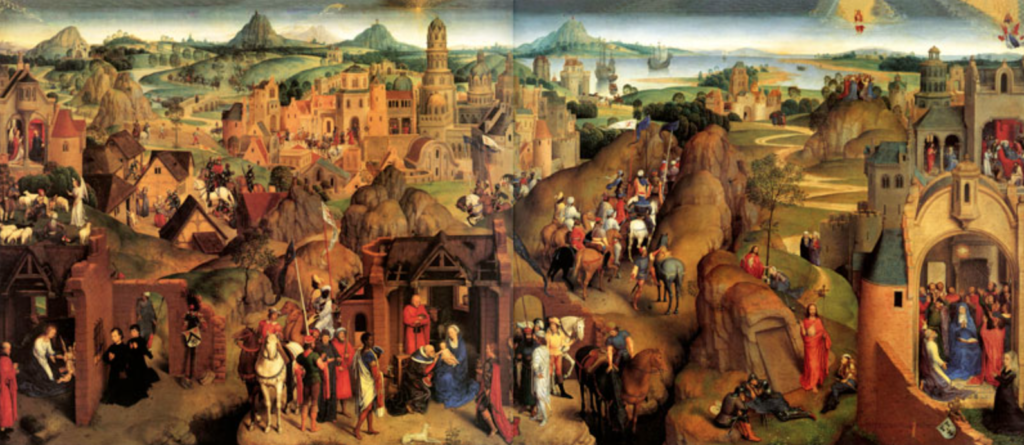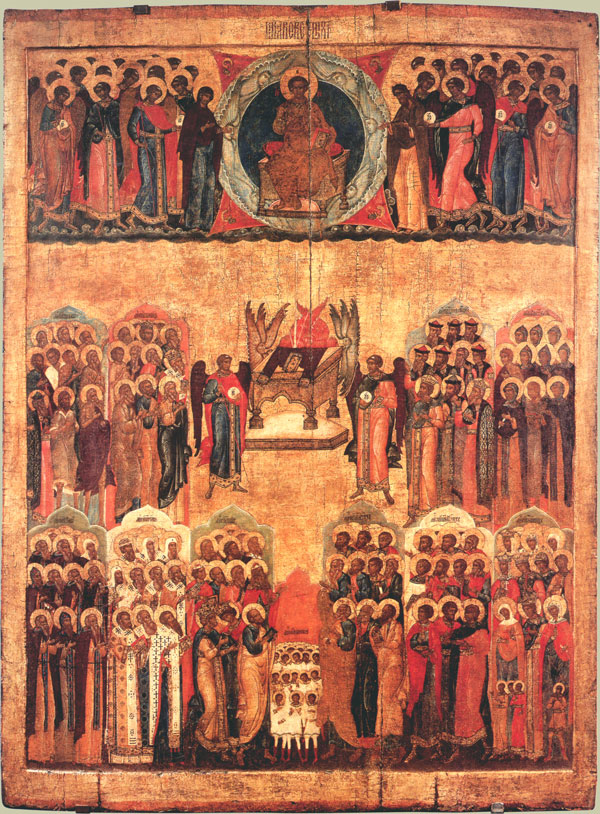
Any time you are dealing with things that relate to the Church’s calendar and liturgical cycle, you might find yourself encountering a few key terms and distinctions regarding the holy days of Christianity. You might ask, “What’s the difference between a feast, a festival, and a commemoration?” “Why are some days considered one thing and other days considered another?”
Well the short answer is that there is no short answer to those questions! In fact, these things have caused great debate, consternation, and discussion within the Christian world for generations and generations. Accordingly, the two of us at All the Household don’t really have anything special to say on the topic; however, we thought it was important that we present you with some of the key ideas behind these categories and the reasons why they matter (and why you ought to be familiar with them when you are planning your own liturgical observances).
With that comes a disclaimer: the Lutheran Church—Missouri Synod officially uses just a few terms when it comes to our holidays, and this helps to keeps things simple. The Roman Catholic Church, however, has many more terms that describe the ranking of liturgical holidays. Further, these concepts delineate what liturgical practices might be used for that day (ex: the Gloria may be recited but not the Creed). While the LCMS’s terms and the terms of the Roman Catholic Church might frequently overlap for a given holiday, we generally try to follow Lutheran language here on our blog, and this post reflects that.
As with anything new, it is important first to get a grasp of the definitions at play. Many of us didn’t grow up in homes where terms like “feast,” “festival,” and “commemoration” were familiar to us. Perhaps you did live in a home where the Annunciation was celebrated annually or even talked about frequently. But for others of us, we might have heard the title “Annunciation” and simply thought “Announcing what??” Moreover, many of us likely didn’t understand why the Annunciation is one of the most important days on the Church’s calendar.
Having a grasp on the rankings of feasts, festivals, and commemorations is simply a good thing for you to know, but it will also help the household for practical purposes. First off, by better understanding these terms you will know which days to prioritize! Liturgical living certainly doesn’t mean celebrating every single commemoration on the calendar, no matter how great or small. That would be wonderful, but most find that some discretion is needed if you are being honest about just how much you can do in a month. So, we encourage you to start with the big days that are all about Jesus!

Feasts & Festivals
So, what do feasts and festivals mean? These terms refer to the most highly prioritized annual observances on the Church’s calendar. Together with the Sundays and seasons of the Church year (which we discuss more here), feasts and festivals make up the “meat” of our liturgical cycle. While the two terms of “feast” and “festival” are often used interchangeably within the Lutheran Church, there is still some distinction in terms of what matters. The most important concept to keep in mind is the primacy of the principal feast days.
Principal Feasts
Within the first category of feasts and festivals (LSB xi) comes the designation of principal feasts, which are the highest ranking holidays on the Lutheran calendar. Most have to do directly with the life of Christ, but a small handful of the other most important and oldest holidays are included as well, such as All Saints’ Day and the Nativity of St. John the Baptist. Liturgically speaking, these feasts are the main organizers of the Church year. They largely give structure to why the Church seasons fall when they do and what the Church is looking forward to most within its yearly cycle. Here are the main feasts:
January 1 – Circumcision and Name of Jesus
January 6 – The Epiphany of Our Lord
January 13 – The Baptism of Our Lord (The Octave of Epiphany)
February 2 – The Purification of Mary and the Presentation of Our Lord
March 25 – The Annunciation of Our Lord
June 24 – The Nativity of St. John the Baptist
July 2 – The Visitation
September 29 – St. Michael and All Angels
November 1 – All Saints’ Day
December 25 – The Nativity of Our Lord
As you likely notice, there are a few important feasts missing from this list. The Resurrection of Our Lord (Easter), the Ascension of Our Lord, and Pentecost are all also principal feasts, but the dates on which they fall change each year.
These holy days are usually closely connected to the broader seasons in which they fall; the feasts of Christ each have their own significance. These days serve as times when we remember, celebrate, and give thanks for the life that our Lord Jesus Christ lived for us in the flesh. For these reasons, as part of our observance of these feasts, it is appropriate to include receiving the Sacrament of the Altar, “in which the Word-made-flesh draws close to us and gives himself to us in much the same way that he came and lived among the apostles and other disciples in the New Testament.”
This is why these major feasts are historically observed by the Church first and foremost together in communion and why the dates are considered the most important within the entirety of the liturgical framework.

Commemorations
So, then what are commemorations (LSB xii-xiii)? By and large this category refers to the rest of the days that fall on the calendar, including the ones set aside throughout the year as opportunities to remember the saints who have gone before us. These are most of the days of the sanctoral cycle: they are important to the flavor of Lutheran liturgical life as our Lutheran Confessions indicate a number of reasons why the commemoration of the saints should occur (Augsburg Confession, Article 21).
The Lutheran Church—Missouri Synod notes that in observing these days, “we are given examples of the Christian faith and life, which God uses to strengthen our own faith and to encourage us in living according to his Word. In a similar way, when we remember examples of those who were called to repentance and forgiveness by the grace of God in Christ, we are reminded of his grace toward us and his forgiveness of our sins.”
There are many, many saints who are part of the Lutheran liturgical calendar (not only the 120+ listed on pages xii-xiii of the LSB but also the ones whom Loehe lists in his martyrology). Loehe thought that a saint should be observed every day of the year and worked hard to renew an awareness and respect for a variety of saints who had gone overlooked. He found that some of the figures included in the Roman calendar were questionable and therefore omitted them from his Lutheran version, prioritizing Old Testament characters and including more women. You can see a full version of Loehe’s calendar here, including the names of many saints who we’ve found important to write about here on the blog but who aren’t part of the LSB collection. The saints are most often remembered and celebrated on the anniversaries of their death, although alternative dates are used when necessary.
So how should we consider these other figures? Well, the commemorations of other saints from the Old Testament and throughout the history of the Church on earth are obviously still important, but they are generally ranked less highly than observances of events and people found in the Gospels. These are figures that are good to remember and observe within the daily prayer structure of a family, in a Christian day school or other educational setting, and/or in parishes where it is possible to gather for Matins or Vespers during the week.

Ranking
What happens though, when these days intersect? When one of the principal feasts such as the Ascension of our Lord occurs at the same time as one of the sanctoral days such as the commemoration of Ss. Cyril and Methodius on May 14? How do you know which one to celebrate or observe?
Well first of all, it is important to keep in mind that the Lord’s Day and the Time of Easter are preserved first and foremost. While the sanctoral calendar and days of the saints are good, they should not be in competition with Christ and/or detract from the Sundays and seasons of the Church Year. Instead, they should complement the natural ebb and flow of the liturgical calendar.
Secondly, saints’ days that are part of the Gospel story itself should also take a higher position and be more carefully interwoven into one’s liturgical celebration over, let’s say, St. Cecilia. This is why figures such as the Virgin Mary and St. John the Baptist receive such high acclaim and multiple observations over the course of the year. One should always think about how a certain holy day points to the cross and especially the most festive times of the year such as Christmas and Easter.
However, even if certain observances run into each other on the calendar or multiple important holy days on the Church calendar occur at the same time, it doesn’t mean that you still can’t learn about and celebrate these figures and days. You will just have more things to keep in mind when planning your celebration and teaching those around you about them!
Other considerations might be kept in mind, as well: the traditional rankings of various days and how to react when multiple observances overlap are all points of some debate among clergy and scholars and something you should ask your pastor about! While you don’t personally have to have a complete handle on things or an idea of the exact “right” way to prioritize celebrations, we hope that you can at least be a little more informed about the contours of the liturgical cycle and the ways that feasts, festivals, and commemorations all matter.
References:
1. Lutheran Service Book: Companion to the Services. Edited by Dr. Paul Grime. Concordia Publishing House. 2022.
2. Lutheran Service Book. Concordia Publishing House. 2006.
Images:
1. Scenes from the Advent and Triumph of Christ, Hans Memling, Belgium, ca. 1480.
2. Master of St. Bartholomew Altar, Baptism of the Lord, ca. 1485-1500.
3. Church of the Resurrection in Kishert. Delivered by Nikita G. Stroganov, ca. 1616.
4. Saint Michael Fighting the Dragon, Albrecht Durer, Germany, 1498.

